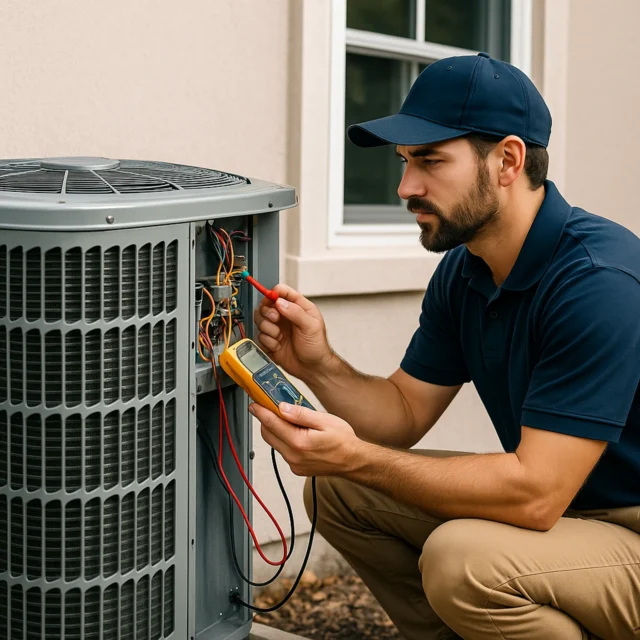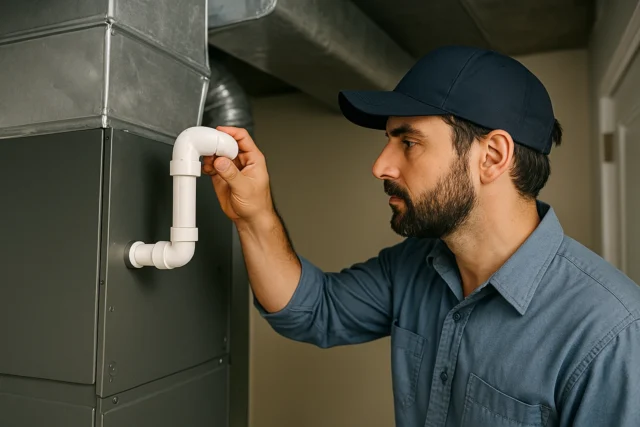Home Humidity Control: The Key to Healthier Air and Comfort

Keeping the right moisture balance in your home isn’t just about comfort — it’s about protecting your health, your HVAC system, and even your furniture. If your home feels stuffy, too dry, or constantly uncomfortable, it may be time to take home humidity control seriously.
Let’s explore how humidity affects your daily life, how modern air handlers can help, and what you can do to maintain an ideal indoor environment.
Why Home Humidity Control and Balance Is So Important
Humidity represents the amount of water vapor in the air. When levels rise too high, the air feels heavy, sticky, and promotes mold growth. When humidity drops too low, air becomes dry and irritating — cracking wood furniture, drying out skin, and causing sore throats.
Ideally, your home should stay between 30% and 50% humidity year-round. This range keeps air comfortable, prevents allergens, and reduces strain on your HVAC system.
Inconsistent humidity can also increase energy costs since your system works harder to maintain comfort. That’s why humidity control should always be part of a complete HVAC strategy.
How the HVAC System Helps Control Moisture
Your HVAC setup already influences humidity more than you might realize. Air conditioners remove moisture as they cool, while heaters dry the air further in winter. But this natural process isn’t enough to maintain perfect balance.
That’s where the air handler comes in. Acting as the command center for air circulation, filtration, and temperature regulation, your air handler can dramatically improve your indoor comfort by distributing air evenly and preventing moisture buildup.
If your system lacks humidity management, professionals can integrate dehumidifiers or humidifiers directly into your existing HVAC system.
You can read more about system upgrades and air balancing on the A Customer First AC website.
When Your Home Needs Humidity Help
Humidity imbalance often shows up through subtle signs before it becomes a big problem.
Here are the most common ones:
Persistent dryness — dry throat, cracked lips, or static electricity.
Condensation on windows — indicates too much moisture.
Mold or musty odors — signals high humidity or poor air circulation.
Inconsistent temperatures — rooms that feel different despite identical thermostat settings.
Any of these could mean your air handler or ductwork needs calibration or maintenance.
How Technicians Regulate Home Humidity
When HVAC experts assess your home, they typically:
Inspect the air handler, filters, and vents for airflow obstructions.
Check ductwork for leaks allowing outdoor moisture in.
Recommend a whole-home humidifier or dehumidifier if needed.
Calibrate smart thermostats to automatically regulate humidity levels.
This ensures optimal comfort and efficiency — especially during seasonal changes.
To explore humidity solutions and system optimization, visit A Customer First AC’s Air Service Page.
The Role of Air Handlers in Moisture Management
Air handlers are the heart of your HVAC system. Modern models use variable-speed fans and sensors to constantly adjust airflow and maintain consistent humidity levels.
They help by:
Preventing hot and cold spots between rooms.
Filtering out fine dust and allergens that thrive in moist air.
Reducing stress on the HVAC compressor by balancing airflow.
Improving indoor comfort across all seasons.
If your current air handler isn’t performing well, upgrading to a humidity-responsive system could be one of the best home comfort investments.
Seasonal Humidity Guide (Simplified for Homeowners)
Each season affects indoor air differently. Here’s how to maintain comfort all year:
Winter: Indoor humidity often drops below 30%, leading to dry air, static, and wood shrinkage. Use a humidifier or ensure your air handler maintains moisture.
Spring: Outdoor air becomes wetter, and indoor humidity can climb quickly. Keep levels around 40–45% to avoid mold and dust mites.
Summer: High temperatures naturally increase indoor moisture. Maintain 40–50% humidity to keep your AC efficient and prevent sticky air.
Fall: As temperatures drop, indoor air dries again. Aim for 35–45% humidity to prepare for heating season while avoiding dryness.
Staying within these ranges keeps your HVAC system efficient, protects your home’s structure, and ensures long-term comfort.
Simple Tips to Improve Indoor Humidity
You don’t need to be a technician to maintain better air. Here are quick, effective steps:
Use exhaust fans wisely. Run them during showers or cooking to remove excess humidity.
Fix leaks immediately. Even a small plumbing leak can upset your humidity balance.
Clean or replace filters monthly. Dust-clogged filters trap moisture and reduce system efficiency.
Inspect doors and windows. Air leaks allow moist outdoor air to enter during summer.
Use a hygrometer. A small humidity monitor helps you track indoor levels and act before problems arise.
Air Quality and Humidity Work Together
Proper humidity management directly enhances indoor air quality. Too much moisture leads to bacteria, mold, and allergen growth; too little allows dust and irritants to circulate more easily.
Balanced air not only feels better but also helps your HVAC filter work more effectively — trapping microscopic particles that would otherwise recirculate.
If you’ve noticed an increase in allergies or respiratory issues at home, schedule an HVAC inspection through A Customer First AC.
Energy Efficiency and Cost Benefits
Stable humidity reduces how often your HVAC cycles on and off. Less cycling means less wear and tear — and more savings. A well-balanced indoor climate can reduce energy consumption by up to 15–20%.
Over time, consistent humidity control also extends equipment lifespan and improves your family’s health, making it one of the most valuable long-term HVAC upgrades available.
Why Invest in a Whole Home Humidity Control
Portable humidifiers and dehumidifiers help small spaces but aren’t practical for the entire home. Whole-home systems automatically maintain balanced humidity using sensors connected to your thermostat.
They’re silent, low-maintenance, and integrated with your existing air handler — offering continuous comfort and protection for your HVAC system and home interior.
If you want a cleaner, healthier home environment, a professional installation is the smartest move.
Final Thoughts: Balanced Air for a Better Life
Humidity control goes hand-in-hand with air quality and comfort. The right air handler setup doesn’t just maintain temperature — it manages airflow, moisture, and cleanliness all at once.
Partner with A Customer First AC to get the most from your HVAC system. From seasonal tune-ups to advanced humidity integration, their experts can help you achieve perfect home comfort year-round.


